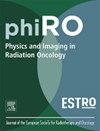Comparative treatment planning of very high-energy electrons and photon volumetric modulated arc therapy: Optimising energy and beam parameters
IF 3.4
Q2 ONCOLOGY
引用次数: 0
Abstract
Background
Very High-Energy Electron (VHEE) beams offer potential advantages over current clinical radiotherapy modalities due to their precise dose targeting and minimal peripheral dose spread, which is ideal for treating deep-seated tumours. To aid the development of clinical VHEE machines, this study adressed the need to identify optimum VHEE beam characteristics for tumours across various anatomical sites.
Materials and methods
VHEE treatment planning employed matRad, an open-source treatment planning system, by adapting its proton pencil beam scanning implementation. VHEE beam characteristics were generated using TOPAS Monte Carlo simulations. A total of 820 plans were retrospectively created and analysed across 10 pelvic and 12 thoracic cases and compared against clinical photon VMAT plans to identify the most optimal VHEE beam configuration and energy requirement.
Results
VHEE plans outperformed photon VMAT in sparing organs-at-risk (OARs) while maintaining or improving target coverage. While 150 MeV served as the threshold for effectively treating deep-seated sites, 200 MeV was identified as a more optimal energy in the pelvis for achieving the best balance of penetration and sparing abutting OARs. Lower energies (70–110 MeV) also benefitted mid-to-superficial disease in the lung cohort. Typically, VHEE plans required 3–5 fields, and resulted in notable dose reductions to OARs across treatment sites, including: 22.5% reduction in rectal Dmean; 13.8% decrease in bladder Dmean; 8.2% reduction in heart Dmean; and a 24.4% decrease in lung V20Gy.
Conclusion
The study reinforces VHEE’s potential in clinical settings, emphasising the need for varied energy ranges to enhance treatment flexibility and effectiveness.
高能电子和光子体积调制电弧治疗的比较治疗计划:优化能量和光束参数
超高能量电子束(VHEE)由于其精确的剂量靶向和最小的外周剂量扩散,比目前的临床放疗方式具有潜在的优势,是治疗深部肿瘤的理想选择。为了帮助临床VHEE机器的发展,本研究解决了确定不同解剖部位肿瘤的最佳VHEE光束特征的需要。材料与方法:采用开源治疗计划系统matRad,采用质子铅笔束扫描实现。利用TOPAS蒙特卡罗仿真生成了VHEE波束特性。回顾性地创建并分析了10例骨盆和12例胸部病例的820个计划,并与临床光子VMAT计划进行比较,以确定最佳的VHEE光束配置和能量需求。结果vhee计划在保留危险器官(OARs)的同时保持或提高目标覆盖范围方面优于光子VMAT计划。虽然150 MeV是有效治疗深部部位的阈值,但200 MeV被认为是骨盆中实现穿透和保留相邻桨的最佳平衡的更优能量。较低能量(70-110 MeV)也有利于肺部队列中的中浅表疾病。通常情况下,VHEE计划需要3-5个领域,并导致OARs在治疗部位的剂量显著减少,包括:直肠Dmean减少22.5%;膀胱平均下降13.8%;心脏平均值降低8.2%;肺V20Gy降低24.4%。结论:该研究强调了VHEE在临床环境中的潜力,强调了不同能量范围的需求,以提高治疗的灵活性和有效性。
本文章由计算机程序翻译,如有差异,请以英文原文为准。
求助全文
约1分钟内获得全文
求助全文
来源期刊

Physics and Imaging in Radiation Oncology
Physics and Astronomy-Radiation
CiteScore
5.30
自引率
18.90%
发文量
93
审稿时长
6 weeks
 求助内容:
求助内容: 应助结果提醒方式:
应助结果提醒方式:


